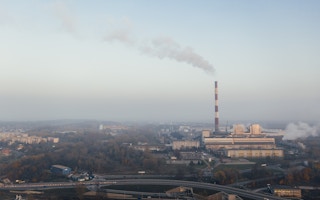There is plenty of room for more of the main greenhouse gas on this planet – as long as it’s caught and trapped in carbon storage underground. New research confirms that when it comes to storage space, there should be no problem about carbon capture and sequestration, known to climate engineers as simply CCS.
Carbon capture is written into intergovernmental plans to combat climate change: the theory is that in addition to stepping up investment in renewable energy such as solar and wind power, existing power plants that run on coal, oil and gas could trap the waste carbon dioxide and literally take it out of atmospheric circulation.
How and on what scale this could be done is still a matter for global debate. But at least there is no problem about whether there is safe storage for the compressed and liquefied greenhouse gas.
New analysis from two scientists at Imperial College London in the journal Energy & Environmental Science suggests that if capture and storage accelerates now and continues at a growing rate, along with other recommended action, then no more than about 2,700 billion tonnes of carbon dioxide would need to be pumped back down abandoned oil shafts and other reservoirs, to keep global warming to less than 2°C above pre-industrial levels by 2100. This is an international target agreed in Paris in 2015.
Differences persist
Since most calculations conclude that there could be available subterranean storage space for around 10,000 billion tonnes of the gas, this suggests that storage itself is not the problem.
CCS sounds like a good idea: the prosecution of that idea has been contentious. Some climate scientists have worried that it is a distraction from the real challenge: to stop burning coal, oil and gas.
Others have been concerned with the lack of public investment; yet others have been troubled by the bigger question of whether a potentially volatile greenhouse gas can be kept in the ground safely for many thousands of years.
So CCS is at most only part of the answer to the problem: nations still have to make the switch to renewable sources, use all energy more efficiently, adjust global dietary demand and take steps to restore the world’s great forests to prevent climate catastrophe: one in which planetary average temperatures surpass 3°C, and sea levels rise by up to a metre before the end of the century.
“
Our study shows that if climate change targets are not met by 2100, it won’t be for lack of carbon capture and storage space.
Samuel Krevor, senior lecturer, Imperial College
The first attempts to store industrial carbon dioxide exhaust began in Norway in 1996 and although progress has been faltering, over the past 20 years capacity has grown by 8.6 per cent to about 40 million tonnes a year: the Intergovernmental Panel on Climate Change (IPCC) now incorporates CCS as part of the mix of actions needed to contain runaway climate change.
The gap is colossal: right now the world emits 37 billion tonnes, or 37 Gt, of the greenhouse gas every year into the atmosphere to drive ever-faster planetary warning. The technology has a long way to go.
“Nearly all IPCC pathways to limit warming to 2°C require tens of gigatonnes of CO2 stored per year by mid-century. However, until now we didn’t know if these targets were achievable, given historic data, or how these targets related to subsurface storage requirements,” said Christopher Zahasky, who did the study at Imperial College but who has now moved to the University of Wisconsin-Madison.
“We found that even the most ambitious scenarios are unlikely to need more than 2700 Gt of CO2 storage resource globally, much less than the 10,000 Gt of storage resource that leading reports suggest is possible. Our study shows that if climate change targets are not met by 2100, it won’t be for lack of carbon capture and storage space.”
Who will pay?
The researchers considered not the space available but the pace of CCS advance: the faster carbon dioxide is safely stowed away, the less the overall need for subterranean hideaway space. But finally, the answer depends on all the other challenges presented by climate change.
“Our analysis shows good news for CCS if we keep up with this trajectory,” said Samuel Krevor of Imperial College, a co-author. “But there are many other factors in mitigating climate change and its catastrophic effects, like using cleaner energy and transport as well as significantly increasing the efficiency of energy use.”
Commenting on the study, Myles Allen, a geoscientist at the University of Oxford, said: “The good news, from this paper, is that there is a solution.
“The bad news is that CO2 capture and disposal is still completely dependent on public money, which will be in short supply over the coming decade. We have to work out other ways of scaling it up.”
This story was published with permission from Climate News Network.

















